**Approval Granted for Housing Scheme on Former Merthyr Quarry Following Previous Setbacks**


Plans for a 20-unit residential development at the site of a former quarry in Merthyr Tydfil have received the green light from local planning authorities, overcoming earlier objections and a previously rejected application. This decision, announced following a Merthyr Tydfil Council planning committee meeting on Wednesday, 7 May, signals a significant step forward for housing in the Bryntaf area of Aberfan.

The approved proposals involve the demolition of current industrial structures at the Phelps Roofing and Garage site to make way for a mixed development, which will include 14 houses and 6 apartments. The application also incorporates plans for 58 car parking spaces, ensuring that each household would have access to a minimum of two spaces—a point likely to be welcomed by incoming residents.
Access to the proposed new homes would build upon and improve the existing road entrance from Bryntaf, aiming to minimise disruption to the surrounding community. The committee considered the project’s layout, scale, and access as part of the outline application, with the finer details regarding appearance and landscaping set to be addressed in subsequent reserved matters applications.
This is not the first time that plans for housing at this location have been put forward; a previous scheme was dismissed by the council back in September 2022. That earlier proposal failed to pass muster amid concerns that the development’s layout, scale, and height would be out of keeping with the character of the neighbourhood and cause unacceptable levels of overlooking for existing nearby properties, particularly Springfield House on the northern boundary.
Following the initial refusal, the applicants lodged an appeal with Planning and Environment Decisions Wales (PEDW), but this too was rejected in March 2023. The revised scheme, however, has now secured the necessary approval, though not without controversy and local opposition.
Community response has been mixed, as the committee received a petition amassing 141 signatures against the development, alongside 17 letters of objection—several from the same households—and five letters of support. Objectors cited a range of concerns, from fears that the scale of the project would overwhelm both the immediate site and local infrastructure, to worries about losing an established local business and altering the area’s visual character.
Some residents expressed apprehension regarding the potential intrusion on the nearby Aberfan cemetery, and others flagged up worries about increased traffic and the capacity of existing roads to handle both construction and ongoing vehicle use. Health and safety, particularly with regard to parking and congestion, were also recurring themes in objections, as were broader issues of privacy, loss of light, and environmental hazards such as flooding and mine gas risks. The ecological impact, with possible threats to local wildlife like slow worms and owls, added to the list of local anxieties.
Those in favour of the proposed housing, on the other hand, argued that regenerating the former industrial site would enhance the visual appeal of Bryntaf and Aberfan overall. Proponents also highlighted the promise of additional off-street parking and pointed to the economic benefits that new construction and residents might bring to the locality. They stressed that any inconvenience from building works would be temporary and outweighed by longer-term gains.
From the planning report, council officers concluded that, subject to thorough site investigations and any required remediation around ground stability, the location could be made safe for development. It was noted that future building regulation processes would provide further scrutiny to limit health and safety risks.
Engineering and highways officials did not raise any significant concerns about the development’s impact on the local road network, with parking and access provisions considered adequate. Council officers also concluded that the overall scale and layout should not negatively affect the area’s street scene or wider landscape, including sensitive sites such as the cemetery and garden of remembrance. Matters relating to privacy and light loss, they indicated, could be further mitigated in detailed design stages.
Nevertheless, not all committee members were convinced. Councillor Scott Thomas voiced his reservations, arguing that the new plans did little to address the criticisms levelled at the original application. His comments underscore the close scrutiny and continuing debate over developments that shape the future of historic communities like Aberfan.
The approval marks a turning point in a long-running saga and will be closely watched as detailed designs emerge and construction moves closer to becoming reality. The development stands as a microcosm of wider tensions in planning policy, weighing the need for new housing against the imperative to safeguard local character and amenity.